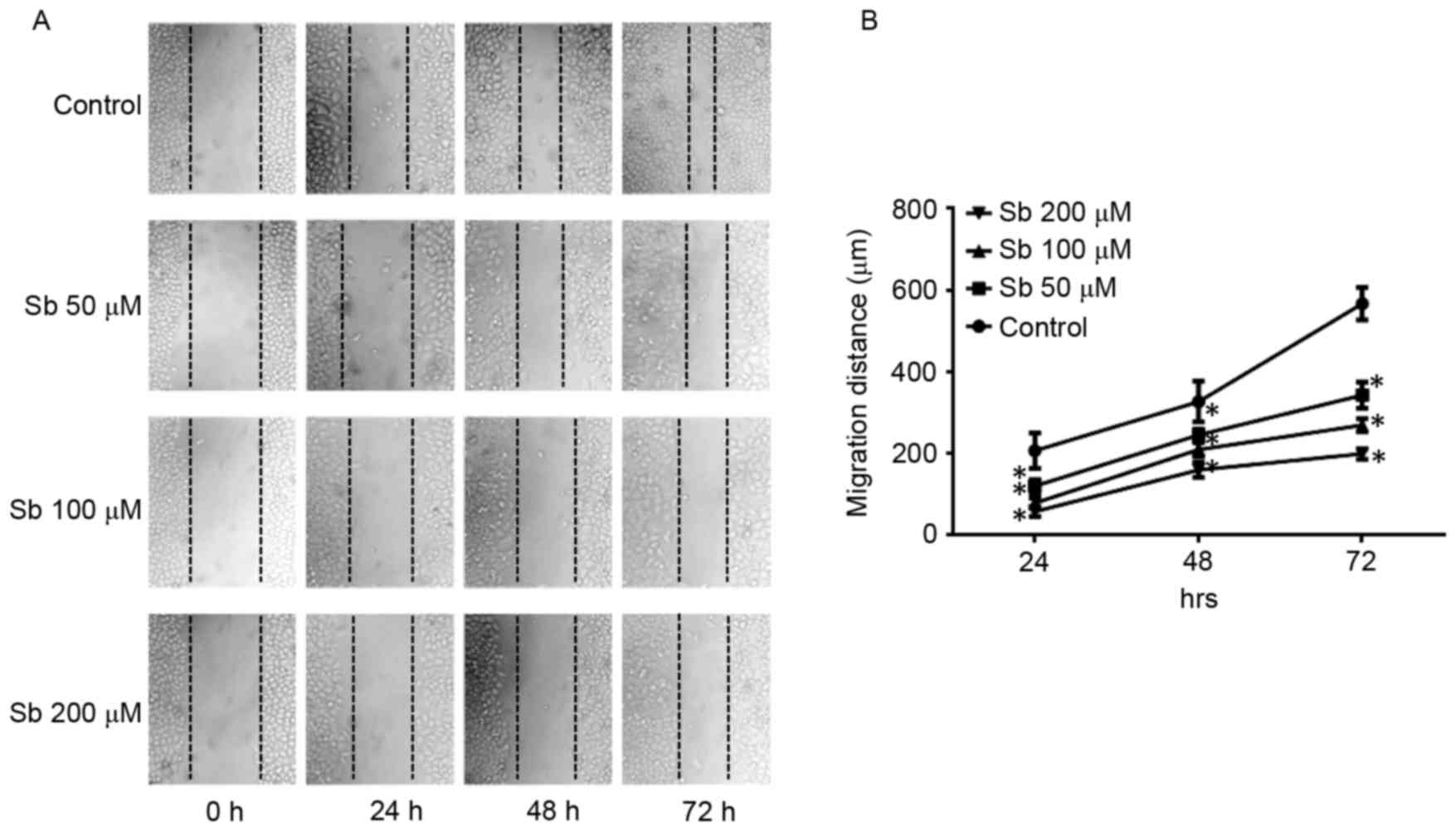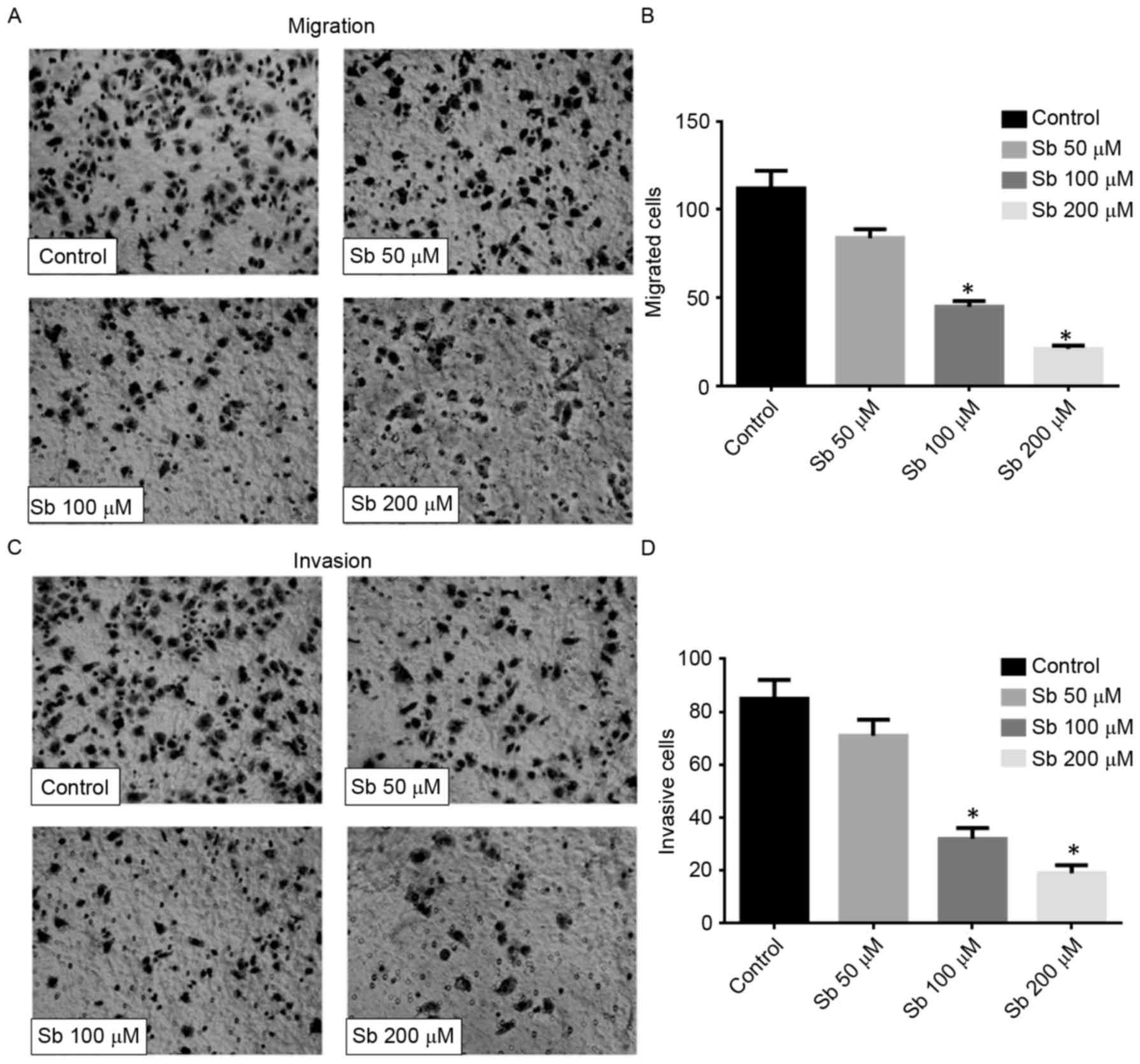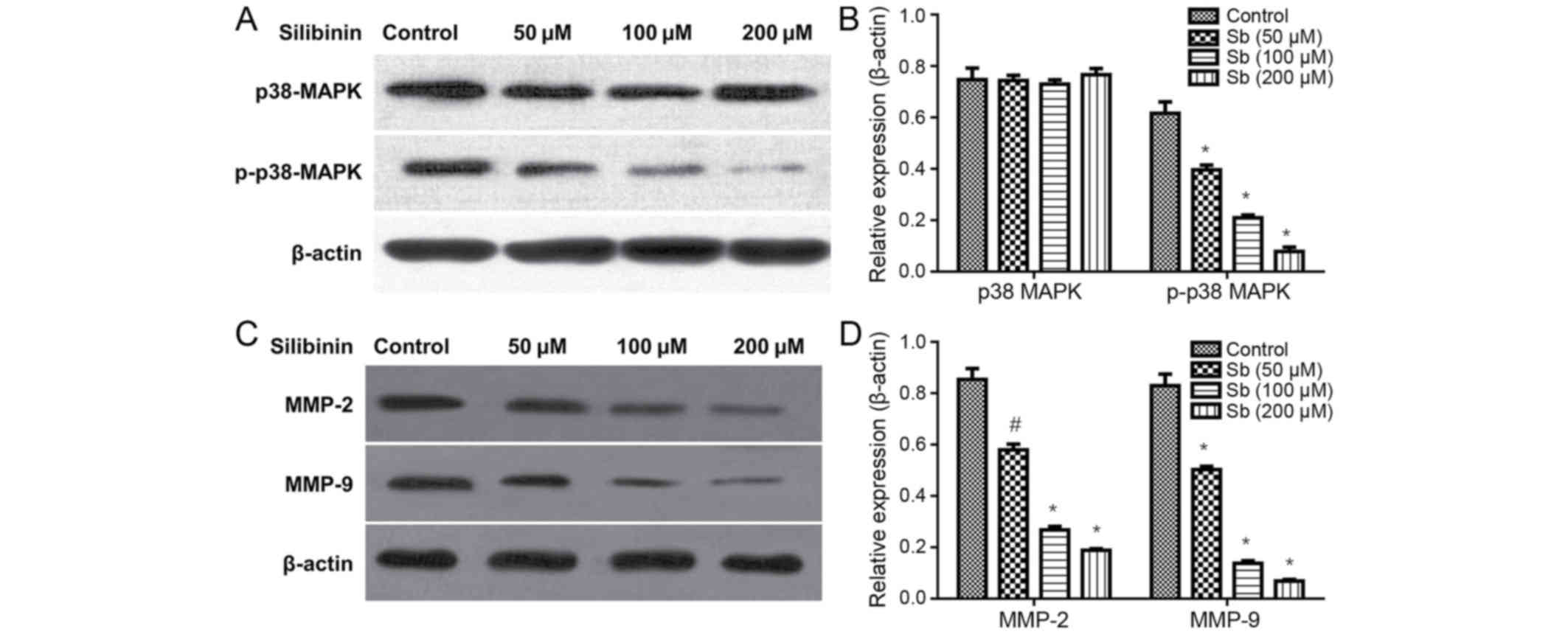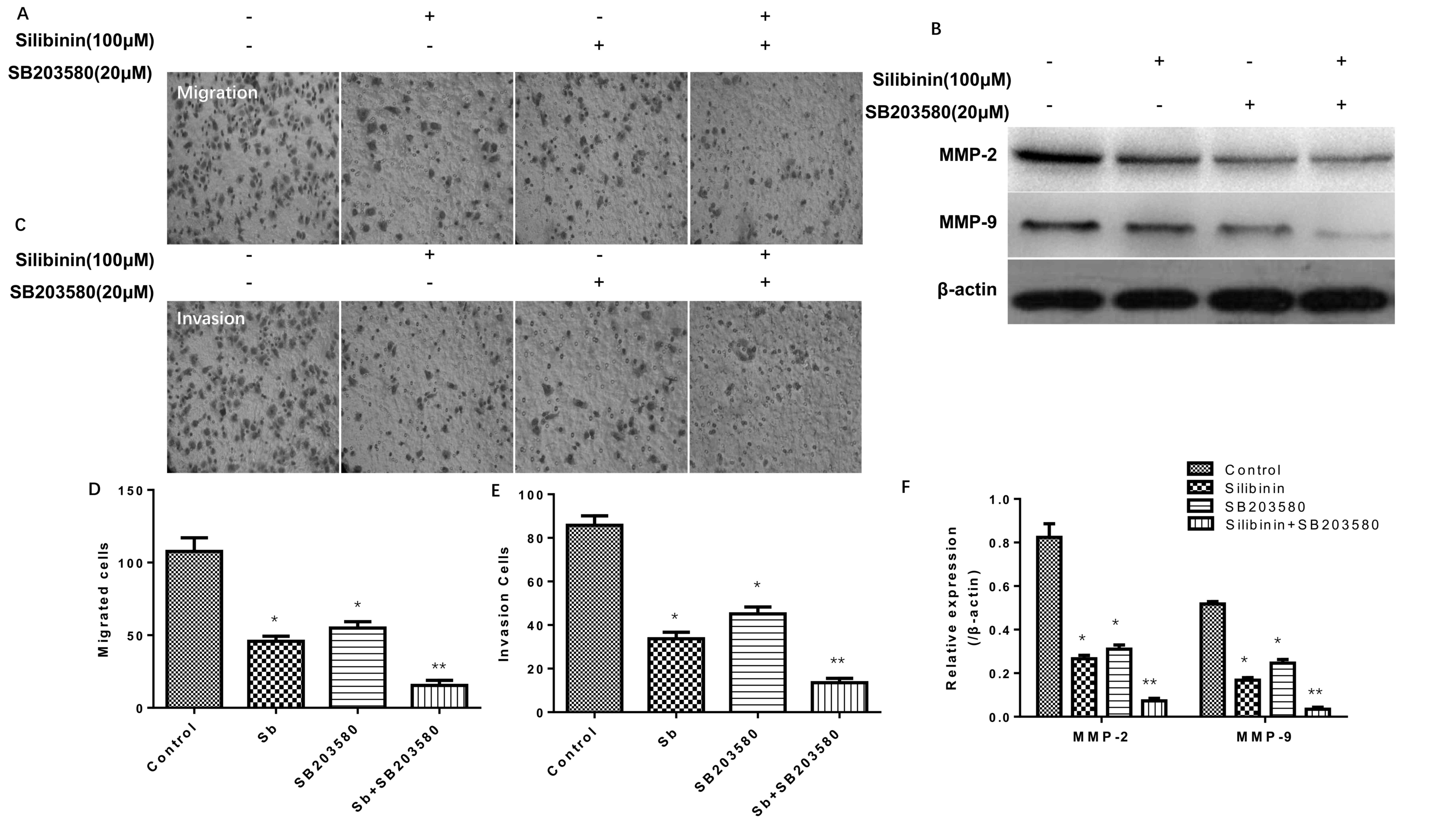Silibinin inhibits the migration and invasion of human gastric cancer SGC7901 cells by downregulating MMP‑2 and MMP‑9 expression via the p38MAPK signaling pathway
Corrigendum in: /10.3892/ol.2021.12676
- Authors:
- Published online on: September 27, 2017 https://doi.org/10.3892/ol.2017.7080
- Pages: 7577-7582
Abstract
Introduction
Invasion and migration, which significantly affect the efficacy of chemotherapeutics (1), have been demonstrated to be the main characteristics of tumor cells (2). Invasion and migration are complicated processes that involve a number of factors (1). For example, migration is closely associated with the degradation of the extracellular matrix (ECM). Tumor cells degrade the ECM and basement membrane (BM) through the function of matrix metalloproteinases (MMPs) and urokinase plasminogen activator (uPA), in order to metastasize to other tissues (3). MMP-2 and MMP-9, which are regarded as the most important factors associated with tumor metastasis, belong to the MMP family (4). It has been established that the inhibition of the expression of MMP-2 and MMP-9 may significantly decrease the degradation of collagen from the ECM and BM in order to prevent the development, invasion and metastasis of cancer cells (5).
p38 mitogen-activated protein kinase (MAPK) is an important signaling transduction factor. Apart from its essential role of in cell proliferation, differentiation and apoptosis regulation, this molecule is also involved in the proliferation, apoptosis and invasion processes of malignant cells (6,7). The invasion and migration capabilities of cancer cells require the activation of specific intracellular signaling cascades, including MMPs. The p38MAPK signaling pathway is considered to serve a key function in cell invasion and migration; for example, it has been demonstrated that p38 may induce the expression of MMP1, MMP3 and MMP13, which regulate matrix remodeling and degradation by metastatic cancer cells (8). In addition, p38a may affect hypoxia-inducible factor 1 and vascular endothelial growth factor, which serve functions in cancer cell survival, angiogenesis and metastasis (9). Multiple genes and cytokines activate the p38MAPK signaling pathway to mediate cell invasion and metastasis in gastric cancer (10,11). It has been established that a specific p38MAPK signaling pathway inhibitor (SB202190) may reduce the multidrug resistance gene 1 expression levels by inhibiting the p38MAPK signaling cascade, thus increasing the sensitivity of gastric cancer cells to chemotherapeutic drugs (12). A number of in vitro studies indicated that MMP-2 and MMP-9 are closely associated with the p38MAPK signaling cascade (13–15).
Silibinin compounds are members of the flavonoids family, and have received attention for their antitumor activities (16–18). Evidence indicates that silibinin may inhibit the proliferation, invasion and migration of tumor cells. Chang et al (19) demonstrated that silibinin may inhibit the invasion and migration of cells, and the growth of tumor cells in nude mice, in addition to enhancing the chemosensitivity of tumor cells to 5-fluorouracil (5-FU) and paclitaxel. The present study aimed to investigate the effectiveness of silibinin and SB203580, a p38MAPK signaling pathway inhibitor (20–24), on the invasion and migration abilities of the gastric cancer SGC7901 cell line, in order to examine the expression of MMP-2 and MMP-9 at the protein and messenger RNA (mRNA) levels, and to elucidate the role of p38MAPK signaling cascades in the processes of invasion and migration in SGC7901 cells.
Materials and methods
Materials
SGC7901 cells were purchased from the Chinese Academy of Medical Sciences' tumor cell library (Beijing, China). The primary antibodies against p38MAPK (dilution, 1:200; catalog no. sc-7972), phosphorylated (p-)p38MAPK (dilution, 1:200; catalog no. sc-17852-R), MMP-2 (dilution, 1:200; catalog no. sc-13594), MMP-9 (dilution, 1:200; catalog no. sc-21733) and -actin (dilution, 1:3,000; catalog no. 130300) were obtained from Santa Cruz Biotechnology, Inc. (Dallas, TX, USA). The horseradish peroxidase (HRP)-conjugated goat anti-rabbit immunoglobulin G(IgG) (dilution, 1:2,000; catalog no. ZDR-5306) and the HRP-conjugated goat anti-mouse IgG (dilution, 1:2,000; catalog no. ZDR-5307) secondary antibodies were purchased from Beijing Golden Bridge Biotechnology Co., Ltd. (Beijing, China). The silibinin compound was obtained from Sigma-Aldrich; Merck KGaA (Darmstadt, Germany). The RPMI-1640 culture medium and fetal calf serum were purchased from Gibco; Thermo Fisher Scientific, Inc. (Waltham, MA, USA). Matrigel was purchased from BD Biosciences (Franklin Lakes, NJ, USA). The Transwell chamber and the TRIzol reagent were obtained from Corning Incorporated (Corning, NY, USA) and Invitrogen; Thermo Fisher Scientific, Inc., respectively.
Cell culture
The gastric cancer SGC7901 cells were cultured in RPMI-1640 medium supplemented with 10% fetal bovine serum (FBS; Gibco; Thermo Fisher Scientific, Inc.), 100 U/ml penicillin and 100 µg/ml streptomycin at 37°C in a humidified atmosphere of 5% CO2.
Wound healing assay
The cells were seeded on 6-well plates at a density of 2×105 cells/ml per well. The complete culture medium was replaced by culture medium without FBS subsequent to cell seeding for 48 h to induce cell synchronization. A 200-µl pipette tip was used to draw a straight line in the longitudinal center of each well, and then each well was washed with PBS twice. The cells were cultured in RPMI-1640 medium containing 50, 100 or 200 µM silibinin for 24, 48 and 72 h. The image was captured by measuring the width of a scratch using the IPP 6.0 software (Media Cybernetics, Inc., Rockville, MD, USA). The cell migration distance formula used was: Cell migration distance (µm)=(initial scratch width-drug treatment scratch width)/2. In the control group, complete medium was added only and it considered 0 µM.
Transwell chamber assay
The Transwell assays were performed in Transwell chambers with 8-µm pore size. The SGC7901 cells were trypsinized (catalog no. 25200056; Gibco; Thermo Fisher Scientific, Inc.) and suspended with 1% FBS. Subsequent to counting cells at a density of 2×106 cells/ml, a 100-µl cell suspension was plated into the upper chamber, and 600 µl medium supplemented with 20% FBS was placed into the lower chamber. Subsequent to incubation at 37°C for 48 h, the cells on the upper surface of the filters were removed and the cells adhering to the undersurface of the filter membrane were fixed with 4% paraformaldehyde for 20 min. Subsequently, Giemsa stain (2%) was added to stain the transferred cells for 30 min at room temperature, cells were then washed with PBS three times. The cells on the lower chamber were counted under an inverted microscope in five random fields. The mean cell numbers were recorded and analyzed. The experiment was repeated three times. For the control group, complete medium was added only.
Matrigel-based invasion assay
The Matrigel assays were performed in Transwell chambers with 8-µm pore size coated with Matrigel at 1:9 dilution in RPMI-1640 medium for 4 h at 37°C (to allow the Matrigel to solidify prior to plating cells). The experimental processes were performed as described above for the Transwell assays.
Western blotting
Equal numbers of cells were lysed in lysis buffer composed of 0.6 M Tris-HCl (pH 6.8), 10% SDS and a protease inhibitor cocktail (catalog no. 78430; Thermo Fisher Scientific, Inc.). Samples were incubated at 4°C for 10 min and then centrifuged at 10,000 × g for 15 min at 4°C. The supernatants were transferred, mixed and boiled in sample buffer (10 ml glycerol, 15 ml 20% SDS, 12.5 ml 4X upper tris, 12.5 H2O). The supernatants were then separated by SDS-PAGE (12% gel) and transferred to a polyvinylidene fluoride membrane. The membrane was then incubated at room temperature in a blocking buffer composed of 5% fat-free milk dissolved in 1X 10 mM Tris (pH 7.5), 100 mM NaCl and 1% Tween 20 (TBST) for 1 h, followed by incubation with the blocking buffer containing the primary antibodies against p38MAPK, p-p38MAPK, MMP-2, MMP-9 and β-actin at 4°C overnight. The membrane was next washed with TBST and incubated with the secondary antibodies for 1 h at room temperature. The blot was exposed to Pierce™ ECL Plus Western Blotting Substrate (catalog no. 32132X3; Pierce; Thermo Fisher Scientific, Inc.) electrochemiluminescence subsequent to TBS washing. The blots were analyzed using ImageJ software 1.4 (National Institutes of Health, Bethesda, MD, USA).
Statistical analysis
All statistical analyses were carried out using the SPSS 13.0 statistical software package (SPPS, Inc., Chicago, IL, USA). Either a two-tailed Student's t-test or a one-way analysis of variance, followed by the Tukey's test, was performed. P<0.05 was considered to indicate a statistically significant difference.
Results
Wound healing assay to detect the effects of silibinin on SGC7901 cell migration
The wound healing assay indicated that silibinin significantly reduced the migration distance of SGC7901 cells at 50, 100 and 200 µM silibinin, in a dose- and time-dependent manner (Fig. 1).
Effect of silibinin on the migration and invasion of SGC7901 cells
The result of the Transwell migration assay confirmed that silibinin significantly reduced the motility of SGC7901 cells, since the number of migrated cells decreased markedly in a dose-dependent manner (Fig. 2A and B). The Matrigel-based invasion assay also indicated that silibinin significantly decreased the invasive ability of SGC7901 cells in a dose-dependent manner (Fig. 2C and D). These data suggested that silibinin may inhibit cell motility and affect the activity of MMPs.
Silibinin effects on cell migration and invasion inhibition may be associated with p38MAPK signaling and MMP expression
Subsequent to treatment with 50, 100 and 200 µM silibinin for 48 h, the total p38MAPK protein levels remained unchanged, but the expression of p-p38MAPK significantly decreased in a dose-dependent manner (Fig. 3A and B). Additionally, it was demonstrated that silibinin decreased MMP-2 and MMP-9 protein expression levels (Fig. 3C and D), in a dose-dependent manner.
Effectiveness of silibinin combined with a MAPK inhibitor in Transwell migration and Matrigel-based invasion assays
The results of the Transwell migration and Matrigel-based invasion assays (Fig. 4) simultaneously indicated that 100 µM silibinin and 20 µM SB203580 (a MAPK inhibitor) (25), independently and in combination, significantly decreased the migration (Fig. 4A and D) and invasion (Fig. 4C and E) of SGC7901 cells, particularly when administered in combination. Additionally, it was observed that silibinin treatment combined with SB203580 decreased the protein expression levels of MMP-2 and MMP-9 concomitantly (Fig. 4B and F).
Discussion
Silibinin has received attention for its hypothetical anticancer effects. It has been suggested that silibinin inhibits cell proliferation, migration and invasion in a number of cancer cell types. Wu et al (26) demonstrated that silibinin significantly inhibited the invasion and migration of prostate cancer cells. Similar results were also revealed in an in vitro breast cancer study (27). Chang et al (19) demonstrated that silibinin inhibited the growth of renal cancer 786-0 cells in a heterograft model, and increased their chemotherapy sensitivity towards 5-FU and paclitaxel. In the present study, the data indicate that the migratory and invasive abilities of SGC7901 cells significantly decreased subsequent to treatment with silibinin in a dose-dependent manner in wound healing and Transwell assays, respectively.
The metastasis of tumor cells is a continuous, multi-step process (3). MMPs are responsible for remodeling the ECM, and it has been suggested that MMPs exhibit important effects on cancer progression (28). Amongst the changes that occur in cancer cells, the ability of tumor cells to modify the surrounding ECM is key. The ECM is an important regulatory component in cellular physiology that provides an environment for cell migration (29). Previous studies have demonstrated that MMPs act on a diverse group of ECM components, including collagens, gelatins, fibronectins and laminins, which serve crucial roles in cancer migration and invasion (30). MMP-2 and MMP-9 are important members of the MMP family. Data from previous studies have suggested that MMP-2 and MMP-9 are highly expressed in gastric cancer tissues compared with their expression in normal tissues (31). Additionally, MMP-2 and MMP-9 were closely associated with lymph node metastasis, lymphatic invasion and prognosis of gastric cancer (32). Similar results have also been demonstrated in vitro, including gastric, ovarian and laryngeal cancer cells (33–35).
The p38MAPK pathway is an important signal transduction cascade that is widely expressed in numerous tissues. This pathway serves a relevant role in a series of cell stress, cytokines recruitment and gene activation activities, including cell proliferation and migration (36). Conversely, extracellular signal-regulated kinase (ERK)1/2, as another transduction factor of the MAPK signaling cascade, may also promote cell proliferation and migration under certain circumstances (37). However, it has been identified that p38MAPK is more active in the process of promoting cell migration, compared with the ERK1/2 signaling cascade (38).
It has been demonstrated that p38MAPK activation may increase MMP-2, MMP-9 and uPA expression levels during tumor metastasis (39). Similarly, the data in the present study indicated that silibinin significantly decreases the migratory and invasive abilities of the SGC7901 cell line in a dose- and time-dependent manner in wound healing and Transwell assays, respectively. Western blot analysis of the cells exposed to silibinin, alone or in combination with SB203580, indicated that the pharmacological mechanism of silibinin may involve the p38MAPK signaling pathway. In conclusion, the present study demonstrates that silibinin, as an underlying inhibitor of p38MAPK, may be regarded as an adjunctive drug for patients with gastric cancer, particularly those suffering from metastatic renal cell carcinoma.
References
|
Mazzocca A and Carloni V: The metastatic process: Methodological advances and pharmacological challenges. Curr Med Chem. 16:1704–1717. 2009. View Article : Google Scholar : PubMed/NCBI | |
|
Bravo-Cordero JJ, Hodgson L and Condeelis J: Directed cell invasion and migration during metastasis. Curr Opin Cell Biol. 24:277–283. 2012. View Article : Google Scholar : PubMed/NCBI | |
|
Hulkower KI and Herber RL: Cell migration and invasion assays as tools for drug discovery. Pharmaceutics. 3:107–124. 2011. View Article : Google Scholar : PubMed/NCBI | |
|
Loukopoulos P, Mungall BA, Straw RC, Thornton JR and Robinson WF: Matrix metalloproteinase-2 and −9 involvement in canine tumors. Vet Pathol. 40:382–394. 2003. View Article : Google Scholar : PubMed/NCBI | |
|
Kessenbrock K, Plaks V and Werb Z: Matrix metalloproteinases: Regulators of the tumor microenvironment. Cell. 141:52–67. 2010. View Article : Google Scholar : PubMed/NCBI | |
|
Kim EK and Choi EJ: Pathological roles of MAPK signaling pathways in human diseases. Biochim Biophys Acta. 1802:396–405. 2010. View Article : Google Scholar : PubMed/NCBI | |
|
Koul HK, Pal M and Koul S: Role of p38 MAP kinase signal transduction in solid tumors. Genes Cancer. 4:342–359. 2013. View Article : Google Scholar : PubMed/NCBI | |
|
Dolado I and Nebreda AR: Regulation of tumorigenesis by p38 MAP kinase. Topics Curr Genet. 20:99–128. 2008. View Article : Google Scholar | |
|
Emerling BM, Platanias LC, Black E, Nebreda AR, Davis RJ and Chandel NS: Mitochondrial reactive oxygen species activation of p38 mitogen-activated protein kinase is required for hypoxia signaling. Mol Cell Biol. 25:4853–4862. 2005. View Article : Google Scholar : PubMed/NCBI | |
|
Lee KH, Kim SW and Kim JR: Reactive oxygen species regulate urokinase plasminogen activator expression and cell invasion via mitogen-activated protein kinase pathways after treatment with hepatocyte growth factor in stomach cancer cells. J Exp Clin Cancer Res. 28:732009. View Article : Google Scholar : PubMed/NCBI | |
|
Boukerche H, Aissaoui H, Prévost C, Hirbec H, Das SK, Su ZZ, Sarkar D and Fisher PB: Src kinase activation is mandatory for MDA-9/syntenin-mediated activation of nuclear factor-kappaB. Oncogene. 29:3054–3066. 2010. View Article : Google Scholar : PubMed/NCBI | |
|
Guo X, Ma N, Wang J, Song J, Bu X, Cheng Y, Sun K, Xiong H, Jiang G, Zhang B, et al: Increased p38-MAPK is responsible for chemotherapy resistance in human gastric cancer cells. BMC Cancer. 8:3752008. View Article : Google Scholar : PubMed/NCBI | |
|
Chou RH, Hsieh SC, Yu YL, Huang MH, Huang YC and Hsieh YH: Fisetin inhibits migration and invasion of human cervical cancer cells by down-regulating urokinase plasminogen activator expression through suppressing the p38 MAPK-dependent NF-kB signaling pathway. PLoS One. 8:e719832013. View Article : Google Scholar : PubMed/NCBI | |
|
Peng CY, Yang HW, Chu YH, Chang YC, Hsieh MJ, Chou MY, Yeh KT, Lin YM, Yang SF and Lin CW: Caffeic Acid phenethyl ester inhibits oral cancer cell metastasis by regulating matrix metalloproteinase-2 and the mitogen-activated protein kinase pathway. Evid Based Complement Alternat Med. 2012:7325782012. View Article : Google Scholar : PubMed/NCBI | |
|
Wang XF, Zhou QM, Du J, Zhang H, Lu YY and Su SB: Baicalin suppresses migration, invasion and metastasis of breast cancer via p38MAPK signaling pathway. Anticancer Agents Med Chem. 13:923–931. 2013. View Article : Google Scholar : PubMed/NCBI | |
|
DE Oliveira DT, Savio AL, Marcondes JP, Barros TM, Barbosa LC, Salvadori DM and DA Silva GN: Cytotoxic and toxicogenomic effects of silibinin in bladder cancer cells with different TP53 status. J Biosci. 42:1–11. 2017. View Article : Google Scholar : PubMed/NCBI | |
|
Polachi N, Bai G, Li T, Chu Y, Wang X, Li S, Gu N, Wu J, Li W, Zhang Y, et al: Modulatory effects of silibinin in various cell signaling pathways against liver disorders and cancer-A comprehensive review. Eur J Med Chem. 123:577–595. 2016. View Article : Google Scholar : PubMed/NCBI | |
|
Jahanafrooz Z, Motameh N and Bakhshandeh B: Comparative evaluation of Silibinin effects on cell cycling and apoptosis in human breast cancer MCF-7 and T47D cell lines. Asian Pac J Cancer Prev. 17:2661–2665. 2016.PubMed/NCBI | |
|
Chang HR, Chen PN, Yang SF, Sun YS, Wu SW, Hung TW, Lian JD, Chu SC and Hsieh YS: Silibinin inhibits the invasion and migration of renal carcinoma 786-O cells in vitro, inhibits the growth of xenografts in vivo and enhances chemosensitivity to 5-fluorouracil and paclitaxel. Mol Carcinog. 50:811–823. 2011. View Article : Google Scholar : PubMed/NCBI | |
|
Lali FV, Hunt AE, Turner SJ and Foxwell BM: The pyridinyl imidazole inhibitor SB203580 blocks phosphoinositide-dependent protein kinase activity, protein kinase B phosphorylation, and retinoblastoma hyperphosphorylation in interleukin-2-stimulated T cells independently of p38 mitogen-activated protein kinase. J Biol Chem. 275:7395–7402. 2000. View Article : Google Scholar : PubMed/NCBI | |
|
Birkenkamp KU, Tuyt LM, Lummen C, Wierenga AT, Kruijer W and Vellenga E: The p38 MAP kinase inhibitor SB203580 enhances nuclear factor-kappa B transcriptional activity by a non-specific effect upon the ERK pathway. Br J Pharmacol. 131:99–107. 2000. View Article : Google Scholar : PubMed/NCBI | |
|
Barancik M, Htun P, Strohm C, Kilian S and Schaper W: Inhibition of the cardiac p38-MAPK pathway by SB203580 delays ischemic cell death. J Cardiovasc Pharmacol. 35:474–483. 2000. View Article : Google Scholar : PubMed/NCBI | |
|
Jin N, Wang Q, Zhang X, Jiang D, Cheng H and Zhu K: The selective p38 mitogen-activated protein kinase inhibitor, SB203580, improves renal disease in MRL/lpr mouse model of systemic lupus. Int Immunopharmacol. 11:1319–1326. 2011. View Article : Google Scholar : PubMed/NCBI | |
|
Zhang H, Wu S and Xing D: YAP accelerates A(25–35)-induced apoptosis through upregulation of Bax expression by interaction with p73. Apoptosis. 16:808–821. 2011. View Article : Google Scholar : PubMed/NCBI | |
|
Lali FV, Hunt AE, Turner SJ and Foxwell BM: The pyridinyl imidazole inhibitor SB203580 blocks phosphoinositide-dependent protein kinase activity, protein kinase B phosphorylation, and retinoblastoma hyperphosphorylation in interleukin-2-stimulated T cells independently of p38 mitogen-activated protein kinase. J Biol Chem. 275:7395–7402. 2000. View Article : Google Scholar : PubMed/NCBI | |
|
Wu KJ, Zeng J, Zhu GD, Zhang LL, Zhang D, Li L, Fan JH, Wang XY and He DL: Silibinin inhibits prostate cancer invasion, motility and migration by suppressing vimentin and MMP-2 expression. Acta Pharmacol Sin. 30:1162–1168. 2009. View Article : Google Scholar : PubMed/NCBI | |
|
Dastpeyman M, Motamed N, Azadmanesh K, Mostafavi E, Kia V, Jahanian-Najafabadi A and Shokrgozar MA: Inhibition of silibinin on migration and adhesion capacity of human highly metastatic breast cancer cell line, MDA-MB-231, by evaluation of 1-integrin and downstream molecules, Cdc42, Raf-1 and D4GDI. Med Oncol. 29:2512–2518. 2012. View Article : Google Scholar : PubMed/NCBI | |
|
Gialeli C, Theocharis AD and Karamanos NK: Roles of matrix metall oproteinases in cancer progression and their pharmacological targeting. FEBS J. 278:16–27. 2011. View Article : Google Scholar : PubMed/NCBI | |
|
Kleiner DE and Stetler-Stevenson WG: Matrix metalloproteinases and metastasis. Cancer Chemother Pharmacol. 43 Suppl:S42–S51. 1999. View Article : Google Scholar : PubMed/NCBI | |
|
Hidalgo M and Eckhardt SG: Development of matrix metalloproteinase inhibitors in cancer therapy. J Natl Cancer Inst. 93:178–193. 2001. View Article : Google Scholar : PubMed/NCBI | |
|
Gerstein ES, Sini L, Ryabov AB, Dvorova EK, Yurchenko AA, Stilidi IS, Kushlinskii NE and Davydov MI: Comparative enzyme immunoassay of matrix metalloproteinases-2,-7,-9 and their tissue inhibitor-2 in tumors and plasma of patients with gastric cancer. Bull Exp Biol Med. 148:899–902. 2009. View Article : Google Scholar : PubMed/NCBI | |
|
Sampieri CL, de la Peña S, Ochoa-Lara M, Zenteno-Cuevas R and León-Córdoba K: Expression of matrix metalloproteinases 2 and 9 in human gastric cancer and superficial gastritis. World J Gastroenterol. 16:1500–1505. 2010. View Article : Google Scholar : PubMed/NCBI | |
|
Weng Y, Cai M, Zhu J, Geng J, Zhu K, Jin X and Ding W: Matrix metalloproteinase activity in early-stage lung cancer. Onkologie. 36:256–259. 2013. View Article : Google Scholar : PubMed/NCBI | |
|
Dragutinović VV, Radonjić NV, Petronijević ND, Tatić SB, Dimitrijević IB, Radovanović NS and Krivokapić ZV: Matrix metalloproteinase-2 (MMP-2) and −9 (MMP-9) in preoperative serum as independent prognostic markers in patients with colorectal cancer. Mol Cell Biochem. 355:173–178. 2011. View Article : Google Scholar : PubMed/NCBI | |
|
Li Y, Ma J, Guo Q, Duan F, Tang F, Zheng P, Zhao Z and Lu G: Overexpression of MMP-2 and MMP-9 in esophageal squamous cell carcinoma. Dis Esophagus. 22:664–667. 2009. View Article : Google Scholar : PubMed/NCBI | |
|
Bradham C and McClay DR: p38 MAPK in development and cancer. Cell Cycle. 5:824–828. 2006. View Article : Google Scholar : PubMed/NCBI | |
|
Huang C, Jacobson K and Schaller MD: MAP kinases and migration. J Cell Sci. 117:4619–4628. 2004. View Article : Google Scholar : PubMed/NCBI | |
|
Wang ZS, Luo P, Dai SH, Liu ZB, Zheng XR and Chen T: Salvianolic acid B induces apoptosis in human glioma U87 cells through p38-mediated ROS generation. Cell Mol Neurobiol. 33:921–928. 2013. View Article : Google Scholar : PubMed/NCBI | |
|
Pan F, Ma S, Cao W, Liu H, Chen F, Chen X and Shi R: SDF-1 upregulation of MMP-2 is mediated by p38 MAPK signaling in pancreatic cancer cell lines. Mol Biol Rep. 40:4139–4146. 2013. View Article : Google Scholar : PubMed/NCBI |













